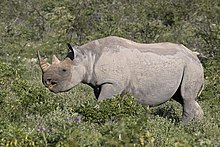South-western black rhinoceros
| South-western black rhinoceros | |
|---|---|

| |
| Female, Etosha National Park, Namibia | |
| Scientific classification | |
| Domain: | Eukaryota |
| Kingdom: | Animalia |
| Phylum: | Chordata |
| Class: | Mammalia |
| Order: | Perissodactyla |
| Family: | Rhinocerotidae |
| Genus: | Diceros |
| Species: | |
| Subspecies: | D. b. occidentalis
|
| Trinomial name | |
| Diceros bicornis occidentalis (Zukowsky, 1922)
| |
The south-western black rhinoceros (Diceros bicornis occidentalis) is a
Taxonomy
This subspecies is often mistaken for either the extinct southern black rhinoceros (D. b. minor). However, the populations in the arid areas of northern Namibia and southwestern Angola represent a separate subspecies.[2]
The
Zoologisches Museum Hamburg (specimen no. 40056) and described as belonging to a new species, Opsiceros occidentalis, by L. Zukowsky in 1922.[3][4] Opsiceros is an invalid synonym of the genus Diceros.[5]
Description
The south-western black rhino, like all black rhino subspecies, has a distinct prehensile lip and is a browser. Its appearance is similar to other subspecies, the most important difference to them is a relatively broad head behind the eyes and minor features in the
individual variation.[5] They also are most adapted to arid habitat and can be found in arid savanna and desert climates.[citation needed
]
Population and threats
Historically, this subspecies once roamed in
South Africa. Its total population is increasing and numbered to 1,920 animals in 2010, with 55.8% adults. Poaching due to increasing horn prices is considered the main threat to their population.[1][5] They successfully breed with the south-central black rhinoceros
.
IUCN status
The
IUCN considers the living northern Namibian black rhino populations to belong to the subspecies D. bicornis bicornis, and does not recognize a separate D. b. occidentalis.[1] This synonymy, based upon du Toit (1987)[6] was, however, considered erroneous by Groves and Grubb (2011), and D. b. occidentalis was re-established as a valid subspecies. As all southernmost populations of black rhinoceros were exterminated by the mid-19th century, D. b. bicornis is completely extinct today.[5]
References
Wikispecies has information related to Diceros bicornis occidentalis.
- ^ . Retrieved 13 November 2021.
- ISBN 978-1-4214-0093-8. Retrieved October 7, 2012.
- ^ Zukowsky, L. (1922). "Vorläufige Mitteilung über eine neue Art des Spitzschnautz-Nashorns aus Südwest-Afrika" (PDF). Archiv für Naturgeschichte. 88A (7): 162–163.
- ISBN 90-5103-134-3. Retrieved October 20, 2013.
- ^ ISBN 978-1-4214-0093-8. Retrieved October 9, 2012.
- ^ du Toit, R. (1987). "The existing basis for subspecies classification of black and white rhino" (PDF). Pachyderm. 9: 3–5.

